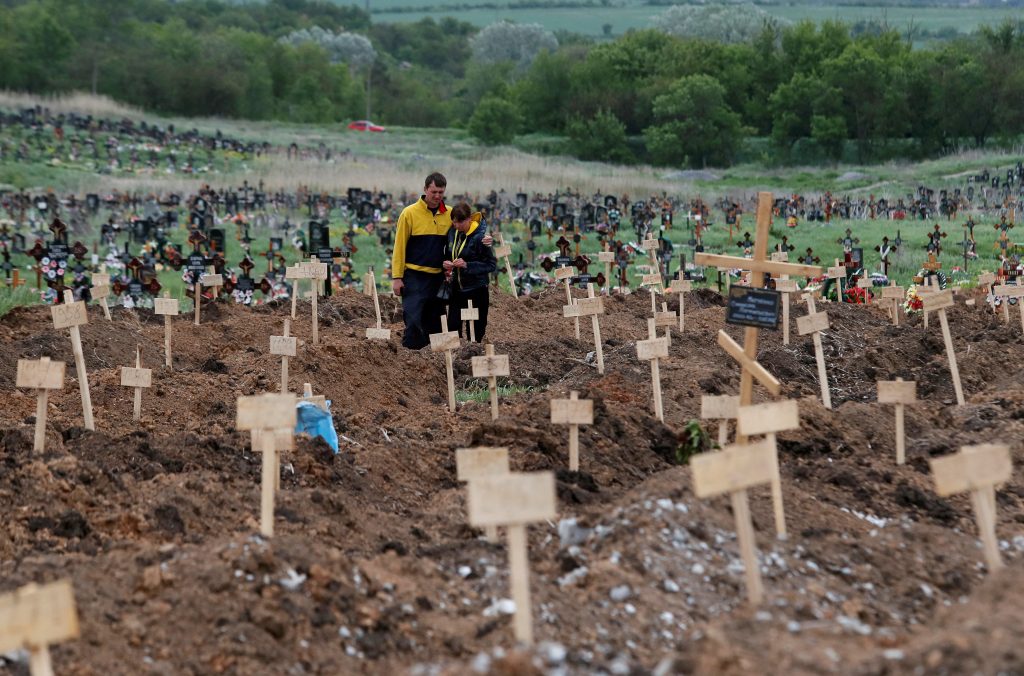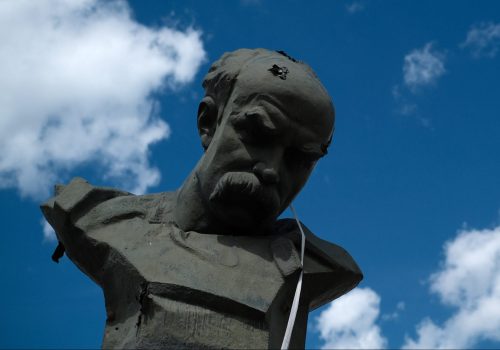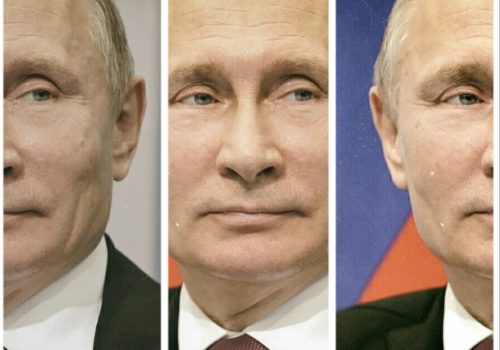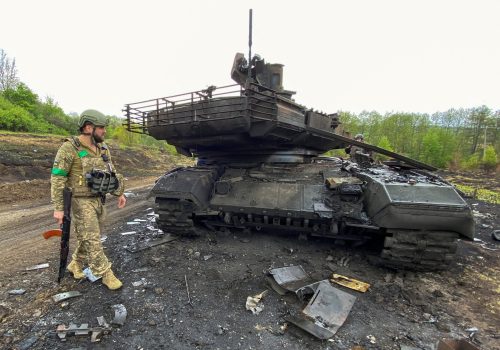The Battle of Mariupol is over and Russia is busy proclaiming the liberation of the city. In reality, Mariupol has been murdered. This formerly bustling metropolis of almost half a million people now lies on the brink of extinction, pummeled into submission by a vicious campaign of Russian annihilation. The estimated 100,000 remaining residents of Mariupol find themselves reduced to living among the rubble without medicines, running water or electricity.
With Russia in control of the city, there is no way of knowing the final death toll or assessing the true scale of the catastrophe that has befallen Mariupol. During the final weeks of the fighting, Mariupol Mayor Vadim Boychenko estimated more than 20,000 civilians had been killed and noted that this was twice the number of deaths recorded in the entire two-year Nazi occupation of the city during WWII. “Putin is a bigger evil than Hitler and we must stop him,” commented Boychenko.
Global audiences have grown used to the apocalyptic scenes in Mariupol and are no longer shocked by the destruction of an entire city. In order to grasp the full extent of Putin’s crime, it is vital to remember Mariupol as it was before the outbreak of war.
Mariupol was always a special city with a diverse population included a large ethnic Greek community. Located on the Azov Sea in southern Ukraine, it was warm and sunny for most of the year. Though the air was thick from the heavy industry located in the heart of Mariupol, local residents tended to be proud of their city and fiercely loyal.
War first came to Mariupol in spring 2014 when Moscow attempted to seize control of the surrounding Donbas region during the initial stages of the ongoing eight-year conflict between Russia and Ukraine. The city was taken over by Russian forces but this occupation proved mercifully brief.
Following liberation, Mariupol gained in significance as the largest city in the Donbas still under Ukrainian control. Located just a few kilometers from the front lines of the simmering conflict with Russia, it became an administrative and economic focus as well as a showcase for the higher living standards and greater personal freedoms offered by Ukraine.
While regions of eastern Ukraine under Russian occupation withered and stagnated, Mariupol flourished. This city was a mirror providing a stark contrast to the atrophy of the Russian-controlled parts of the Donbas. After 2014, Mariupol welcomed a shiny new office of government interaction where people could go to marry and register births without the suffocating and corrupt old-style bureaucracy that Ukraine used to be famed for. Hipster cafes and bars popped up across town, along with sleek co-working spaces and IT hubs. A new highway linked the city to neighboring regions in southern Ukraine.
Mariupol was also a beneficiary of Ukraine’s successful decentralization reforms. The move towards giving local communities more say over how they live their lives and spend their budgets created genuine political competition between people who wanted to serve their communities and not just plunder them. This was strikingly different to the authoritarian model of paternalism promoted in Russia and Russian-occupied eastern Ukraine.
Stay updated
As the world watches the Russian invasion of Ukraine unfold, UkraineAlert delivers the best Atlantic Council expert insight and analysis on Ukraine twice a week directly to your inbox.
Though almost every single building in Mariupol has now been razed to the ground, it is the people who really matter. The personal stories of Mariupol residents deserve to be heard.
By chance, I recently met some refugees who had made it out of the city. Together with a friend, we helped a family of three during the very last stage of their 1200km journey to temporary shelter in western Ukraine. The mother explained how she had escaped Mariupol with her 12-year-old daughter and 11-year-old son. They had made their way across Ukraine together, carrying their few most precious possessions with them including religious icons and a favorite teddy bear.
These survivors used the single word “hell” when attempting to describe what they had lived through in Mariupol. Once they had arrived at their accommodation and completed the check-in process, the mother came to the realization that she had finally brought her children to safety. Overcome with emotion, she let a few tears go before composing herself again. Similar scenes have been repeated countless times over the past few months. This is happening in Europe in 2022.
Those who made it out of Mariupol safely have wept tears of relief for their survival and tears of grief for those they left behind. They are also mourning the death of their hometown. The Mariupol you now see on your TV screens is a crime scene where tens of thousands of civilian lives have been extinguished.
This is not the Mariupol that survivors remember. Their memories are of a beautiful and vibrant place with a strong sense of community where families worked hard to build their dreams. As the location of one of the largest steelworks in Europe, the city was home to some very hard people who routinely did dangerous work and deserved to be respected. This traditional toughness was one of the reasons why Mariupol was defended so valiantly, despite the Russian terror unleashed upon it.
Eurasia Center events

The Kremlin propaganda machine is now attempting to portray the destruction of Mariupol as a Russian victory. Instead, the long defense of Mariupol against overwhelming odds should be remembered as a powerful example of the Ukrainian heroism that has captured the world’s imagination.
The Ukrainian troops who held the vast Azovstal industrial complex for months did so knowing that they faced almost certain death or captivity. They fought on anyway, safe in the knowledge that their stand was pinning down whole units of the Russian army which would otherwise be unleashed elsewhere in Ukraine.
Mariupol must also be remembered as one of the worst crimes against humanity of the twenty-first century. The atrocities committed by Russian troops throughout Ukraine have horrified global audiences and have sparked an international war crimes investigation along with accusations of genocide. Even in this grim context, Mariupol stands out. Putin ordered the destruction of the city despite knowing hundreds of thousands of civilians were unable to flee.
The calculated nature of the onslaught was most immediately apparent in the targeted bombing of Mariupol Drama Theater, which was being used as a makeshift shelter by over 1,000 civilians. Despite large lettering placed on the ground outside the theater spelling out the word “CHILDREN,” Russia hit the building with a devastating and deliberate blast. Current estimates indicate that around 600 civilians were killed in that one attack alone.
Mariupol was destroyed in order to send a chilling message to all Ukrainians of the fate awaiting anyone who refuses Putin’s invitation to join the so-called “Russian World.” The fact that Mariupol was an overwhelmingly Russian-speaking city that had traditionally backed pro-Kremlin political forces only appears to have hardened Putin’s resolve to punish the city for its defiance.
After Mariupol, there can be no more illusions regarding the possibility of a compromise peace with Putin. A city that was once marked by the smells of heavy industry and seaside breezes is now enveloped in the stench of decomposing bodies trapped beneath the rubble. Unless Putin is decisively defeated, more towns and cities across Ukraine will suffer the same fate. The next city in line for such devastation is Severodonetsk in Luhansk Oblast. Others will surely follow. After Mariupol, no European leader can claim they were not forewarned.
Paul Niland is the Founder of Lifeline Ukraine.
Further reading
The views expressed in UkraineAlert are solely those of the authors and do not necessarily reflect the views of the Atlantic Council, its staff, or its supporters.

The Eurasia Center’s mission is to enhance transatlantic cooperation in promoting stability, democratic values and prosperity in Eurasia, from Eastern Europe and Turkey in the West to the Caucasus, Russia and Central Asia in the East.
Follow us on social media
and support our work
Image: People stand amid newly-made graves at a cemetery in the course of Ukraine-Russia conflict in the settlement of Staryi Krym outside Mariupol. May 22, 2022. (REUTERS/Alexander Ermochenko)




